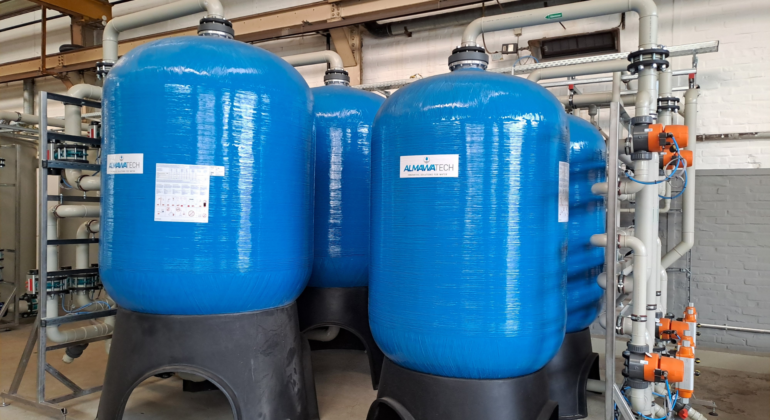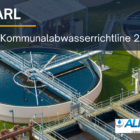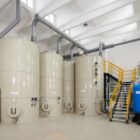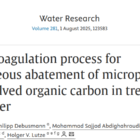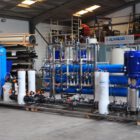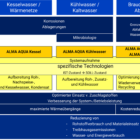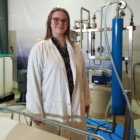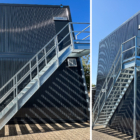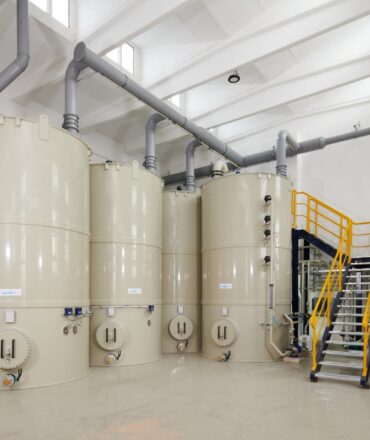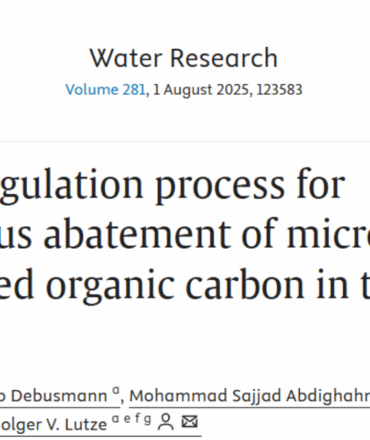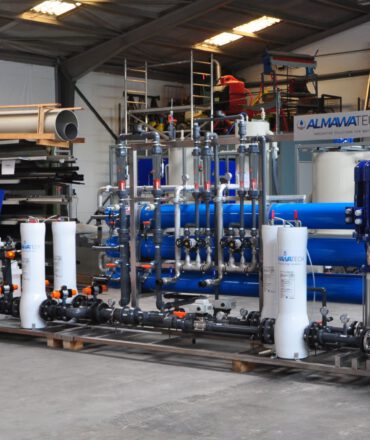Die Wasseraufbereitung ist ein zentraler Bestandteil zahlreicher industrieller Prozesse. Je nach Anwendungsfall müssen bestimmte Ionen oder Verbindungen aus dem Wasser entfernt werden, um die Qualität des Wassers an die jeweiligen Anforderungen anzupassen. Drei der wichtigsten Verfahren in diesem Kontext sind die Enthärtung, die Entcarbonisierung und die Vollentsalzung. In diesem Artikel erklären wir die Funktionsweise und die Vorteile dieser Verfahren, einschließlich der Rolle von Mischbettfiltern für die Feinreinigung.
Inhaltsverzeichnis
Enthärtung: Entfernung von Wasserhärte
Die Wasserhärte wird durch gelöste Calcium- und Magnesiumionen verursacht. Diese Ionen können in Rohren und Anlagen zu Kalkablagerungen führen, die Effizienzverluste und erhöhte Wartungskosten verursachen.
Funktionsweise
Die Enthärtung erfolgt durch den Einsatz von stark sauren Kationenaustauschern (SAC). Diese Austauschharze enthalten Sulfonsäuregruppen, die positiv geladene Ionen wie und binden und gegen Wasserstoff- oder Natriumionen austauschen.
Vorteile der Enthärtung
- Vermeidung von Kalkablagerungen: Schutz von Rohrleitungen, Wärmetauschern und Kesseln.
- Erhöhung der Energieeffizienz: Kalkfreie Systeme gewährleisten eine optimale Wärmeübertragung.
- Kostenreduktion: Geringerer Wartungsaufwand und längere Lebensdauer der Anlagen.
Entcarbonisierung: Entfernung von Karbonathärte
Die Karbonathärte wird durch gelöste Bikarbonationen verursacht, die mit Calcium- und Magnesiumionen reagieren können, um schwerlösliches Calciumcarbonat (Kalk) zu bilden. Die Entcarbonisierung reduziert diese Härte und senkt die Alkalinität des Wassers.
Funktionsweise
Die Entcarbonisierung erfolgt oft mit schwach sauren Kationenaustauschern (WAC), die selektiv Kationen binden, die an Bikarbonate gekoppelt sind. Dabei entsteht Kohlensäure, die in Wasser und CO₂ zerfällt. Um das entstandene CO₂ aus dem Wasser zu entfernen, wird häufig ein CO₂-Riesler nachgeschaltet.
Vorteile der Entcarbonisierung
- pH-Stabilisierung: Reduktion der Alkalinität sorgt für stabilere chemische Bedingungen.
- Kalkvermeidung: Verhindert Ablagerungen und schützt nachgeschaltete Systeme.
- Effizientere Prozesse: Geringerer Bedarf an Chemikalien und verbessertes Betriebsverhalten.
Vollentsalzung: Entfernung aller gelösten Salze
Die Vollentsalzung ist die umfassendste Form der Wasseraufbereitung und zielt darauf ab, alle gelösten Ionen aus dem Wasser zu entfernen. Das Ergebnis ist hochreines Wasser mit minimaler Leitfähigkeit, das für anspruchsvolle industrielle und technische Anwendungen geeignet ist.
Funktionsweise
Die Vollentsalzung kombiniert den Einsatz von stark sauren Kationenaustauschern (SAC) und stark basischen Anionenaustauschern (SBA). Während die Kationenaustauscher alle positiven Ionen wie Calcium, Magnesium und Natrium entfernen, eliminieren die Anionenaustauscher negative Ionen wie Chlorid, Sulfat und Nitrat. Für die höchste Reinheit wird ein Mischbettfilter zur Feinreinigung nachgeschaltet.

Foto: Unsere Kationen- und Anionenaustauscher ALMA ION
Rolle des Mischbettfilters
Ein Mischbettfilter kombiniert Kationen- und Anionenaustauscher in einer einzigen Einheit. Er dient der Feinpolitur, indem er selbst kleinste Restmengen an Ionen entfernt, die durch die vorgelagerten Austauschstufen nicht vollständig eliminiert wurden. Das Ergebnis ist Wasser mit einer Leitfähigkeit von unter 0,1 µS/cm, das für hochsensible Anwendungen wie in der Elektronik- oder Pharmaindustrie notwendig ist.
Vorteile der Vollentsalzung
- Extrem hohe Wasserreinheit: Ideal für empfindliche Prozesse, die höchste Standards erfordern.
- Korrosionsschutz: Minimale Leitfähigkeit verhindert Schäden an Anlagen.
- Flexibilität: Anpassbar für verschiedene industrielle Anforderungen.
Anwendungen von Enthärtung, Entcarbonisierung und Vollentsalzung
Die drei Verfahren finden in einer Vielzahl von Industrien und Anwendungen Einsatz:
- Enthärtung: Besonders in der Haustechnik und in industriellen Kühlanlagen spielt die Enthärtung eine zentrale Rolle. Durch die Vermeidung von Kalkablagerungen in Wärmetauschern, Leitungen und Kesseln wird die Energieeffizienz gesteigert und die Lebensdauer der Anlagen verlängert.
- Entcarbonisierung: Sie ist essenziell für die Kesselwasseraufbereitung, um Korrosion und Kalkbildung zu verhindern. In der Lebensmittelindustrie sorgt die Entcarbonisierung für optimales Prozesswasser, während sie in Kühlsystemen die Ablagerungsgefahr reduziert.
- Vollentsalzung: Die Vollentsalzung ist ein unverzichtbarer Prozess in der Elektronik-, Pharma- und Chemieindustrie. Sie ermöglicht die Herstellung von Wasser mit extrem niedriger Leitfähigkeit, das für Anwendungen wie Halbleiterfertigung, sterile Injektionslösungen und Dampferzeugung in Kraftwerken erforderlich ist.
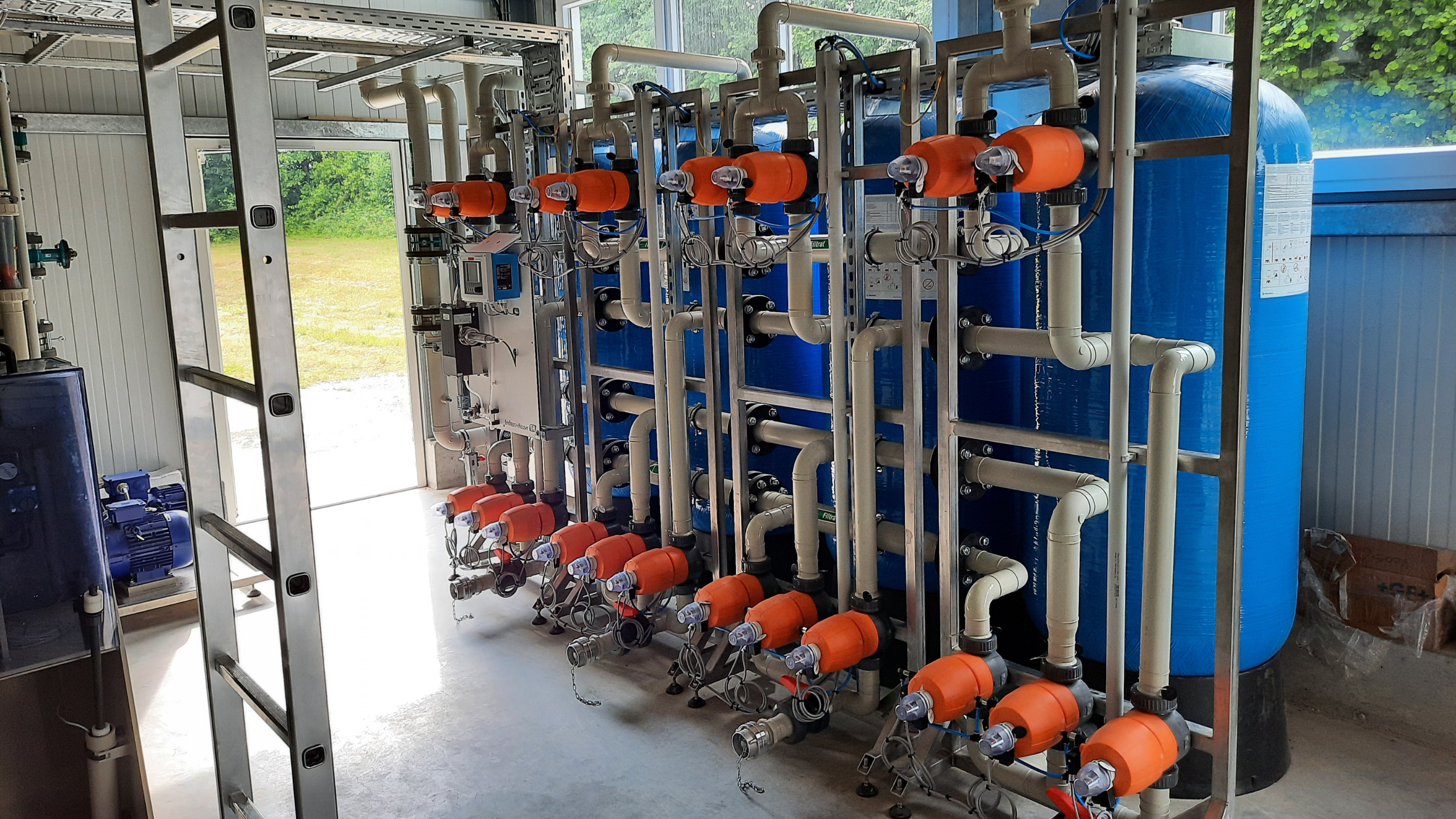
Foto: Unserer Ionenaustauscher ALMA ION mit vorgeschalteten Mehrschichtfilter ALMA Fil
Zusammenfassung
Die Verfahren der Enthärtung, Entcarbonisierung und Vollentsalzung sind essenzielle Bausteine der modernen Wasseraufbereitung:
- Enthärtung: Verhindert Kalkablagerungen und schützt Anlagen vor Verschleiß.
- Entcarbonisierung: Reduziert die Alkalinität, stabilisiert den pH-Wert und vermeidet Karbonathärte.
- Vollentsalzung: Entfernt alle gelösten Salze und erzeugt hochreines Wasser für anspruchsvolle Anwendungen.
Durch den gezielten Einsatz von Mischbettfiltern kann die Wasserqualität weiter optimiert werden, was insbesondere in Bereichen wie der Elektronik-, Pharma- oder Kraftwerksindustrie entscheidend ist. Mit einer professionellen Planung dieser Prozesse lassen sich nicht nur Betriebskosten senken, sondern auch die Effizienz und Langlebigkeit von Anlagen erheblich steigern.
Für weiter Informationen zu unseren Produkten können Sie uns gerne jederzeit kontaktieren!


